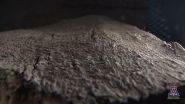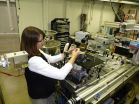Many beetles secrete foul-smelling or bad-tasting chemicals from their abdomens to ward off predators, but bombardier beetles take it a step further. When threatened, they combine chemicals in an explosive chemical reaction chamber in their abdomen to simultaneously synthesize, heat and propel their defensive load as a boiling hot spray, complete with "gun smoke." They can even precisely aim the nozzle at the attacker.
Moore, an assistant professor in the Department of Entomology at the UA College of Agriculture and Life Sciences, just published a paper together with a multidisciplinary team of scientists that not only reveals the beetle's firing apparatus in never-before-seen detail, but also solves a long-standing mystery of how the animals achieve their insane rapid-fire capabilities.
"Understanding how these beetles produce -- and survive -- repetitive explosions could provide new design principles for technologies such as blast mitigation and propulsion," said the lead authors of the study about the motivation for their research. The study was led by doctoral student Eric Arndt and Christine Ortiz in the Department of Materials Science and Engineering at Massachusetts Institute of Technology in Cambridge.
Arndt and Ortiz teamed up with Moore to study the anatomy of the beetle's reaction chamber, which is constructed of cuticle, a composite of chitin, proteins and waxes. The sturdy material, which also makes up the exoskeleton of insects, protects the beetle from the toxic chemicals, high temperatures and high pressures during explosions.
However, the mechanism of the bombardier beetle's spray pulsation had not been understood because previous studies, relying on external observations, could not probe what exactly happens inside the reaction chamber of the chemical gun.
"Twenty-five years ago, a team of scientists from Cornell University and MIT discovered that each blast from the bombardier beetle is actually a series of extraordinarily fast micro-pulses," Moore said. "What wasn't known is what causes each discharge to be pulsed, like a machine gun. Previous researchers suggested that the pulses were caused by muscle contractions or by a fluttering of the exit duct during the explosions."
Using enzymes that digest away muscle and fat, Moore could clean the reaction chamber and examine it with optical microscopy in detail as never before. While studying the shape of the reaction chamber, she noticed that some regions of the chamber wall were thin and not as strong as others, and that one region near the mixing valve looked particularly thin. She predicted that this thin cuticle would be displaced by the force of the reactions in such a way that it would impinge upon the valve, temporarily shutting off the flow of reactants.
To investigate this hypothesis, the team decided to directly observe the internal dynamics of spray pulsation in live beetles of the species Brachinus elongatulus, a species found in riparian habitats throughout southern Arizona.
The team took hundreds of Brachinus beetles to Wah-Keat Lee, a synchrotron scientist who at the time was with the Advanced Photon Source at Argonne National Laboratory in suburban Chicago, to study them with ultrafast X-ray imaging. A co-author of the study who is now at Brookhaven National Laboratory, Lee helped set up an experiment to obtain X-ray video of beetles firing their smoking rounds at up to 2,000 frames per second.
Moore and her collaborators set up the beetles in a tightly sealed room next to the synchrotron -- a particle accelerator that can produce intense X-rays.
"We could manipulate the beetles remotely using robots from a radiation-free control room, while the X-rays penetrated the beetle abdomen, allowing us to visualize the discharges inside," Moore said.
The easiest and least invasive method to get a bombardier beetle to fire is by grabbing one of its legs with forceps. To get usable footage, the researchers had to precisely coordinate the remote handling of the beetles, the X-ray source and the high-speed videography.
"The X-ray source is very intense, but it doesn't kill the beetles," Moore said. "For each experiment we had to cool the beetle down, carefully set it up in the observation chamber such that the X-ray beam was aimed precisely at the defensive glands, seal the doors, walk over to mission control, flip the switch to allow the X-ray beam to enter the room, and use robotic manipulators to remotely touch the beetle's leg so it would blast. In some cases, just turning the radiation on caused them to blast."
Of 500 beetles, the researchers were able to record 30 discharges from 14 individuals, enough to provide high-definition, high-speed video of what happens inside a bombardier beetle's reaction chamber when it goes off. Moore and her collaborators observed how the beetles regulate the ultrafast micro-pulses, something that had never been achieved before.
It turns out the pulses are generated in a passive way, not through an active process involving muscle contraction, as had been hypothesized before. As the chemicals pass through a valve into the reaction chamber, they mix with enzymes and explosively liberate oxygen gas, water vapor and heat, propelling a hot, noxious spray down the nozzle and out the exit pore. Each explosion inside the chamber forces a highly elastic region of the chamber wall -- the thin cuticular area Moore found in her earlier dissections -- to expand and impinge on the valve that separates the two chambers, temporarily cutting off the flow of reactants and resulting in a pulsed delivery.
"It turns out the expansion membrane of the reaction chamber acts as a passive closure mechanism, which is something that had not been described or even predicted before this study," Moore said. "We also discovered that the chamber's anatomy varies between female and male beetles."
While it is still not completely clear why it might be beneficial to the beetle to have a pulsed delivery, Moore suspects that dividing the spray into very short, rapid pulses allows the beetle to sustain the energy of the blast and its small body size at the same time.
"By having a pulsed delivery, these small beetles produce a relatively large amount of defensive spray, which they can aim precisely and with great force and speed," Moore said. "This is truly one of the most remarkable and elegant defensive mechanisms documented to date."
INFORMATION:
Funding information: Use of the Advanced Photon Source was supported by the U.S. Department of Energy (DE-AC02-06CH11357). This work was supported by the MIT Institute of Soldier Nanotechnologies (W911NF-13-D-0001), MIT Center for Materials Science and Engineering (Contract No. DMR-08-19762), National Security Science and Engineering Faculty Fellowship (N00244-09-1-0064 to Christine Ortiz); National Science Foundation (DEB-0908187 to Wendy Moore), and the U.S. Department of Energy (DE- SC0012704).


